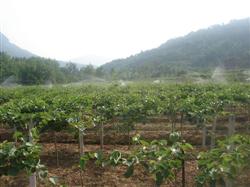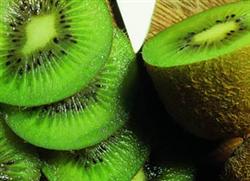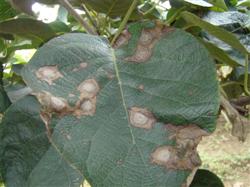Key points of kiwifruit planting technology

Kiwifruit belongs to Actinidia, which is a kind of deciduous vine fruit tree, rich in a variety of vitamins and nutrients, known as the "king of fruit", with high economic value and cultivation value. It is suitable to be planted in mild climate, abundant rainfall, fertile soil, lush vegetation, deep, well-drained, moderately moist black humus soil, sandy loam and slightly acidic soil with pH 5.5-7. 1. The suitable varieties are Hongyang (Hongyang), Heywater, Bruno, Qingcheng No. 1, Qinmei, Miliang No. 1, Chuanyi No. 2, Chuanyi No. 3, Chuanji No. 4 and so on. Second, raising seedlings 1. The fully ripe fruits were collected from the first ten days of September to the first and middle of October. After ripening and softening, squeeze the fruit together with the seeds, rub them in a gauze bag, separate the seeds from the pulp, then rinse repeatedly with clean water, and spread the washed seeds indoors to dry. Soak the seeds in 40-50 ℃ warm water for 2 hours, then soak them in cold water for one day and night, and then sow them in sand for 50-60 days. Kiwifruit seeds are afraid of dry and wet in the process of sand storage, so they should be checked and turned frequently to prevent mildew. The sowing time is generally ideal from mid-March to early April. One is to choose the nursery where the soil layer is deep and fertile and where the drainage, irrigation and transportation conditions are good; the other is to prepare the soil, apply sufficient base fertilizer, remove sundries, the width of the nursery is about 1 meter, slightly suppress the nursery bed, pour water through it, and sow the seeds of sand storage with sand. After sowing, sprinkle a layer of fine river sand about 2mm thick and cover it with straw, which is sprayed with water or covered with plastic (11410, 25.00, 0.22%). The third is to strengthen the seedbed management to ensure the cultivation of robust rootstock seedlings. two。 The suitable grafting period for grafted seedlings is about 20 days before germination, mainly by single bud cutting and other methods, selecting the scion with full growth and small pith, and cutting the branch with a bud, which is 3-4 cm long. Choose the straight side to cut off the skin, the cutting surface is 2 cm long and 3 cm long, the depth is appropriate to expose xylem or slightly with xylem, and the reverse side of the cutting side is cut to a short oblique surface of about 50 degrees. Cut the rootstock at 10-15 cm above the ground, select a smooth downward cut, the cutting surface is slightly longer than the cutting surface of the scion, and the depth is the same as that of the scion, peel the rootstock 2 and 3; then insert the scion, requiring that the size of the scion is basically the same as the rootstock; pay attention to the layer alignment of the rootstock, and then wrap it with plastic grafting film to expose the scion bud. 3-4 weeks after grafting, the buds began to sprout, and the binding film could be removed after the new plants grew a little bit and basically aged. After the abdominal grafted seedlings survive in spring and autumn, cut the anvil immediately, which is about 4 cm away from the interface. After the survival of bud grafting in summer, you can first fold the anvil and then cut the anvil. Timely erasing the sprouts on the rootstock is the key to survival. The nursery should often be ploughed and weeded, and be careful not to encounter the buds that have just been sent out when weeding. After sprouting and sprouting, a pillar should be set up next to the grafting bud, and the new shoot should be tied to the pillar. The seedlings should be properly coring when they are 60 centimeters high. Combined with irrigation, human manure, pig manure, etc., or 1% urea can be added to the water, and calcium superphosphate can be added to fertilize in July to promote the aging of seedling branches and full bud eyes. Kiwifruit seedlings from July to August should take shading measures to avoid direct exposure to strong light. Third, garden construction 1. The root system of kiwifruit selected in the garden is fleshy, especially fragile, not only afraid of waterlogging, but also afraid of high temperature and drought, new shoots are not only afraid of strong wind breaking, but also afraid of late spring cold or low temperature freezing injury. Suitable for planting in sub-high mountain areas (800-1400 meters above sea level), choose places with deep soil, fertile soil, loose texture, good drainage and convenient transportation to build a garden, such as cultivating kiwifruit in low mountains, hills or plains, we must have appropriate drainage and irrigation facilities to ensure that there are no stains in the rainy season and timely irrigation in the dry season. It is best to build windbreaks around the park. two。 During the planting period, the best planting period in the southern producing area is from the defoliation of kiwifruit to the sprouting of kiwifruit in the early spring of the following year, that is, from early December to the first and middle of February, the earlier the better. 3. The configuration of pollination trees kiwifruit is a dioecious fruit tree, and the selection and configuration of male pollination plants is one of the conditions to ensure normal fruit. The selection of male plants should be the same as or slightly earlier than the main varieties, with a large amount of pollen and a long florescence. The ratio of female to male plant is 6 ∶ 1 or 5 ∶ 1, which has high yield and good quality. 4. Generally, the planting density is closely related to the cultivation frame type, the planting density is 2 meters × 4 meters away from home, 3 meters × 4 meters per mu, 56 plants per mu and 3 meters × 5 meters per mu. 5. The scaffold is generally set up in the winter of the same year after planting, which is divided into pillars (cement columns, wooden columns, stone columns, bamboo columns and associated trees, etc.), beams (cement columns, wooden columns, bamboo and metal, etc.), and the surface of the shed is made of iron wire. According to the local situation, wood frame, steel frame, concrete frame and accompanying tree frame are selected, and the frame type is mainly "Y" frame and "T" frame. 6. There are three kinds of frame commonly used in kiwifruit production, which are hedge frame, T-shaped frame and top frame. Fence: the pillar is 2.6 meters long, 12 centimeters thick, 80 centimeters buried, and the ground is 1.8 meters high. Four lines of antirust iron wire are drawn on the shelf surface from bottom to top, and the first wire is 60 cm from the ground. A pillar is erected every 8 meters, and the branches are tied to the wire of the frame. T-frame: a horizontal beam is arranged at the top of the upright pillar to form a small T-shaped bracket. The total length of the pillar is 2.8 meters, the total length of the beam is 1.5 meters, three high-strength antirust iron wires are drawn on the beam, the depth of the pillar is 80 cm, and the net height of the upper part is 2 meters, with a pillar every 6 meters. Flat-roofed scaffolding: the frame is 2 meters high and has pillars every 6 meters. The pillars in the whole garden can be arranged in a square. The pillar has a total length of 2.8 meters and is buried in 80 centimeters. The pillars around the scaffolding are connected by triangular iron or steel bar, and the pillars are drawn by thick and thin iron wire to form a flat-roofed scaffolding. 4. the main diseases and insect pests are flower rot, anthracnose, vine blight, brown spot, fruit soft rot, Phytophthora blight, root rot and beetles, through-wing moths, flower bud maggots, fruit sucking armyworm and so on. Comprehensive control methods should be adopted to strengthen management, strengthen tree potential, strengthen soil disinfection and strengthen prevention. In addition, fruit sunburn mainly strengthens tree potential management and reasonable pruning. During the period of fruit growth and development (late August), bagging can prevent sunburn.
- Prev

Key points of kiwifruit planting
Rich in a variety of vitamins and nutrients, known as the "king of fruit", has high economic value and cultivation value. Suitable for mild climate, abundant rainfall, fertile soil, lush vegetation, soil with deep, well-drained, moderately moist black humus soil, sandy loam, pH 5.5-7 slightly acidic soil.
- Next

Identification and control of kiwifruit branch blight
Kiwifruit branch blight, also known as dehydrated branch blight, is a physiological disease caused by climatic factors, which is caused by no man-made fertilizer or drug damage, as well as pathological root rot, branch rot, canker and so on. the phenomenon of sudden wilting and death of fruiting branches or vegetative branches. First, symptoms of the disease.
Related
- Moge, come on! The staff of the peasant association in the producing area of cantaloupe were frightened when the crowd gathered.
- Causes and Solutions of low Fruit setting rate of Apple
- Symptoms and control measures of passion fruit virus disease
- Fruit growing lesson: how do apple orchards keep high yields?
- Can you build orchards in the mountains? What are the pros and cons?
- How to manage the coloring period of Crisson grape?
- This paper introduces the processing technology of two kinds of fig products.
- How much is a month for retired teachers in rural areas by 2020?
- How can strawberry planting increase sugar content? We should pay attention to management in many aspects.
- What are the cultivation techniques on how to improve the yield of golden fruit?

